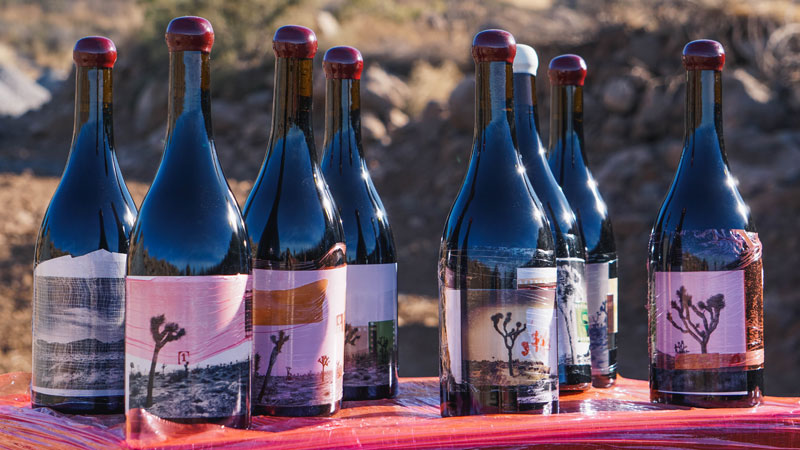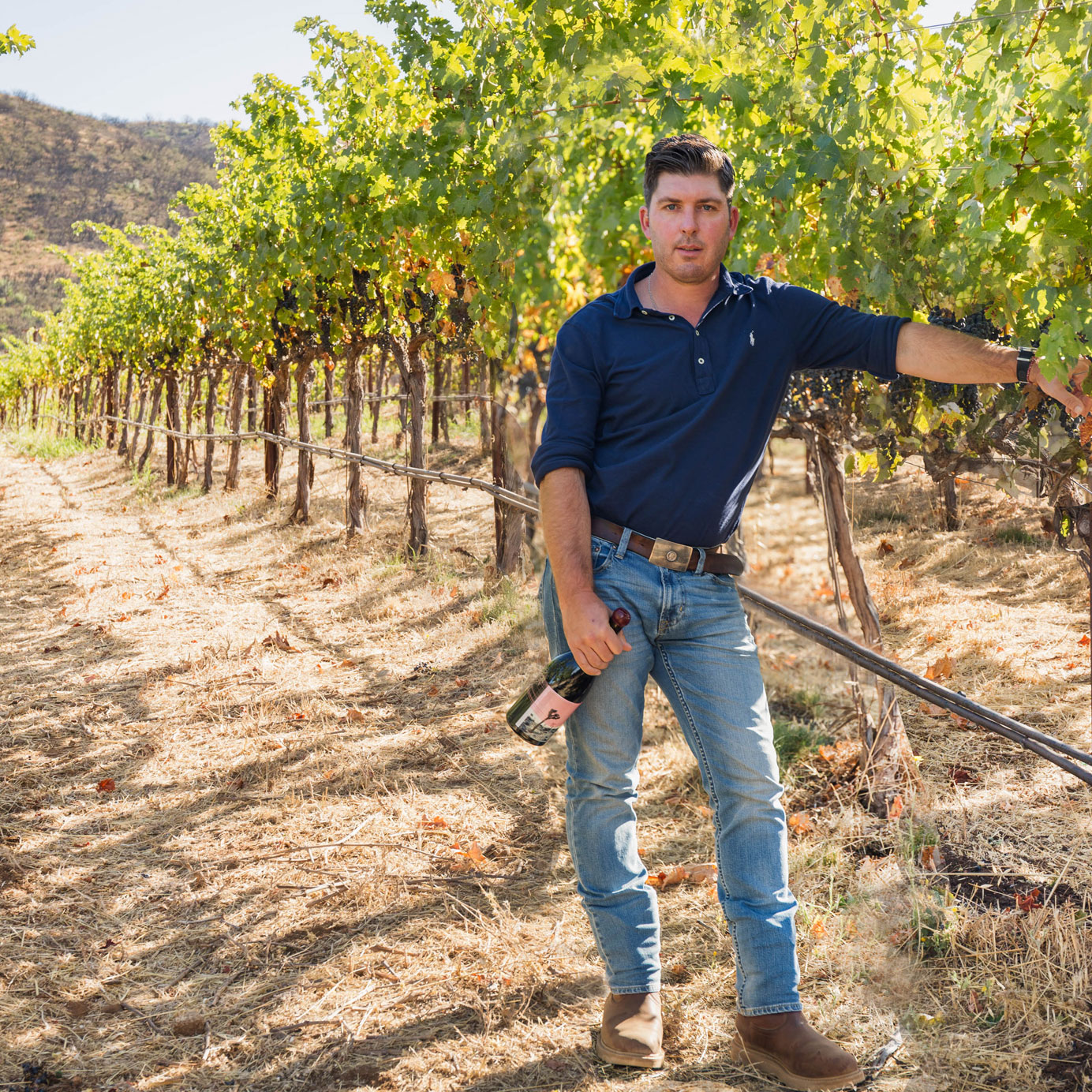“Fifty percent of the people who pick up a wine buy it because of the label,” Dave Phinney, the maverick behind The Prisoner, the 21st century’s first “viral” wine, tells me on a private jet ride over South Florida. I am joining him to taste the 2017 vintage of his new wine label, 8 Years in the Desert. It’s a red blend with a lot riding on it.
The name 8 Years in the Desert gets its name from a sentence Phinney recently served in varietal purgatory. After selling The Prisoner to Huneeus Vintners in 2008 (he later sold its parent company, Orin Swift Cellars, to E&J Gallo in 2016), he signed a non-compete, agreeing not to make Zinfandel for eight years. Now, he’s finally free to produce it for Orin Swift Cellars.
As with The Prisoner, which had an eye-catching Francisco de Goya etching on its label, 8 Years in the Desert is creatively packaged. Just 3,500 cases of the 2016 vintage have been released to collectors, each bearing a different mixed-media label. All were personally designed by Phinney, a lover of all things tactile, including magazines, books, and skateboards (a holdover obsession from his youth). One of these labels has been used on the 2017 vintage as well; the other seven will follow in subsequent vintages.
Phinney says his wines are more than cool branding. He believes he “overdelivers on quality while under-delivering on price.” (SRP for 8 Years in the Desert is $50.)
Todd Wernstrom, director of sales for limited-production wine importer and distributor The French Corner, agrees. “I tend to avoid labels like his because they usually suggest to me, and it’s often borne out in the glass, that the producer is selling what’s on the bottle rather than what’s inside it,” he says. “Phinney is the exception to that rule.”
The Prisoner made waves by being utterly unique yet widely accessible. Can Phinney capture lightning in another beautifully designed bottle?
*
In numerology, the digit “eight” stands for money, ambition, power, success. The shape is also important: On its side, the number eight looks like an infinity sign, with both sides equal, representing balance between creation and execution.
Phinney’s decision to name his new label 8 Years in the Desert had more to do with legality than numerology, but the number does anchor some of the wine’s marketing. The 40,000-case commercial release of the 2017 vintage had an auspicious date: August 8, 2018.
At the moment, the current plan is to release exactly eight vintages of 8 Years in the Desert, after which “we’ll figure something out,” Phinney says. “By nature, wine takes time. So should marketing.”
Eric Rydin, certified sommelier and owner of Le Grand Triage in New York City, compares Phinney to Andy Warhol, “another genius of marketing and art.” Both masterfully straddle creativity and commerciality, making work that has mass appeal and a deeply personal point of view.
“Similar to ‘pop art,’ what Dave has created is ‘pop wine,’” Rydin says. “So his decision to do only eight vintages and create a theme around the numeral doesn’t seem silly or random; it is an artistic decision that, in my opinion, is born from marketing more than romanticism.”
He’s done so without the typical tools, too. Unlike many 21st-century marketing success stories, Phinney doesn’t rely on social media to build his brand.
“Instagram is not a world that I live in,” Phinney says. “I remember when Facebook or MySpace or whatever was invented. I was at the height of my international travel. I thought, I could look like the most interesting man in the world right now. But I didn’t want to be that douche posing next to an airplane, with a ‘Wheels Up’ [hashtag].”

Instead, to generate enthusiasm for 8 Years in the Desert, he wrote a Hemingway-esque short story of the same name, styled after “Hills Like White Elephants.” Phinney, who started writing at his wife Kim’s suggestion, intends to turn it into a short film, similar to the highly stylized sales video he made for the label’s launch.
“Not everyone can articulate their vision. Phinney can. That’s what sets him apart,” Wernstrom says. Phinney’s wines attain cult status in part because of “the graphics, the skate art, the crazy names,” Wernstrom says. The other parts? “Legit juice” and influential tastes.
“Phinney is a master of this type of marketing,” Wernstrom says of 8 Years in the Desert’s digital buzz. “In fact, he was essentially doing it before the medium existed. That’s genius. And unlike many who are at the vanguard of anything and end up failing because they are just a little too ahead of the curve, Phinney was already rolling along at the creation of this thing called social media.”
*
Phinney’s commitment to winemaking and exceptionally savvy marketing is rivaled by a hearty disregard for the status quo. Even at age 45, he dislikes authority for authority’s sake. Terroir? Single varietals? Site-specific bottlings? These tried-and-true techniques matter less to Phinney than simply procuring the best grapes to make the most drinkable blends. (And, as terms and tools, they mean nothing to digital influencers.)
His audience – the youngest of Gen-Xers and millennials – appreciates his viticultural subversion. They are thirsty for cool and eager to ignore previous generations’ wine rules.
Appealing to young, possibly inexperienced wine drinkers raises concerns among some other winemakers. “Since his wines are very geared toward Americans, and young ones at that, the style is rich, dark, jammy, and hedonistic,” Rydin says. “It is not difficult to imagine that producers of wine all over the world will begin to cater toward that market.”
Rydin worries that Phinney’s ability to drive trends could lead young wine consumers to think that all wine should taste big, bold, and jammy, and that “they may lose appreciation for other styles of wine,” he says. “The dangers of Dave Phinney becoming the measuring stick of good wine amongst young, millennial drinkers is that this style will become ubiquitous with all wines, not just the one style.”
This is a valid concern. Anyone who lived through the overly malolactic, oaky California Chardonnays of the 1990s and 2000s — about which the industry is just beginning to revise its collective thinking — shudders to think about the widespread embrace of one approach.
On the other hand, it’s arguably unfair to hold someone’s popularity against them. Besides, Warhol opened the conversation about art. He didn’t prevent other artists from embracing the classics, or forging their own paths.
Phinney isn’t particularly worried. For one thing, he’s not likely to take much stock in anybody’s opinion but his wife’s and his own (and maybe his Gallo colleagues’). He’s humbler than one might expect of someone hosting a tasting aboard his own private airplane.
And, in middle age, he is inherently aware of his strengths and weaknesses. “I’m the worst salesman,” he says. “It’s an art. I’m sure you can be taught — some. But I just want to get back to my work. Being in the vineyard all day, I’m much more comfortable.”
He especially dislikes being judged for his headline-making accomplishments, which dismiss his work ethic. “People obsess about the money. Yes, there has been luck and there has been timing. But I missed every single one of my buddies’ weddings. And if on that day of signing a big contract, my wife and I were in a fight, it would mean nothing to me,” he says.
*
Trends change. Consumer tastes are fickle. Phinney has become remarkably successful by embracing his own iconoclasm. There is no reason to think he won’t continue to do so.
It’s a set of conditions that doesn’t exist for many other winemakers. There are factors working in Phinney’s favor that extend beyond timing and luck. Yet few other individual winemakers are capable of making wines that sell out before they are released.
Phinney has taken Samuel Beckett’s idea of “failing better” to heart. Even though he’s happier than he likes to admit with 8 Years in the Desert, and enjoys working with the giants of Gallo, he says imposter syndrome is a necessary part of his process.
“I’ve never really made a wine that I like,” he says. “The issues I have with the wines are mine, but I never really want that insecurity to go away. The more I practice, the better I get. I never want to be satisfied.”
